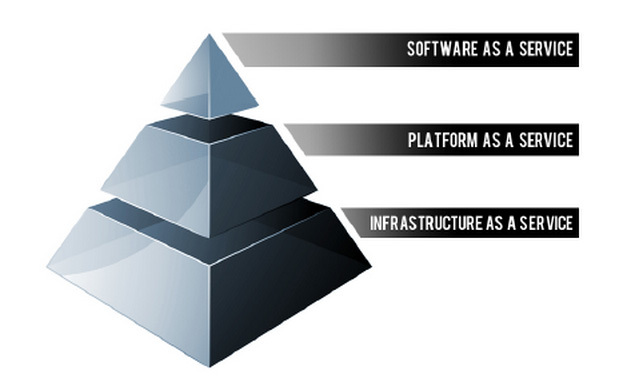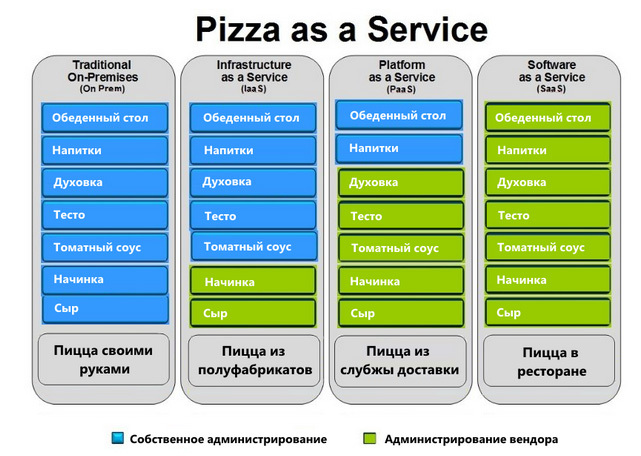Just about corporate IaaS: what it is, for whom, and how it is paid

Over the past few years, cloud services have penetrated into many areas of life and business - as a result, many varieties of similar resources and corresponding abbreviations have appeared (SaaS, PaaS, IaaS).
Understand all this variety of options and understand why we need each of them is quite difficult - even employees of IT companies often see clouds mainly as a tool for storing information and nothing more.
')
In today's article we will look at the entire stack of cloud technologies and dwell on one part of it - corporate IaaS.
Like pizza, only cloud
The stack of cloud technologies consists of three parts, each of which represents a separate category of services:
- SaaS - applications running in the cloud, access to which end users get through the web.
- PaaS is a set of tools and services that facilitate the development and deployment of cloud applications.
- IaaS is a computing infrastructure (servers, data warehouses, networks, operating systems) that is provided to clients for deploying and running their own software solutions.
The described scheme can be represented as a diagram:

Clearly the differences between the key types of cloud services can be illustrated using the concept of “Pizza as a Service” - in which “clouds” are compared with pizza. If a consumer wants to come to a restaurant and order a pizza there - this is SaaS, if he pays home delivery, then this is PaaS, and if he buys ingredients at the store and prepares pizza for himself - the analogy with IaaS:

Today we will take a closer look at just this last option.
What is IaaS
Infrastructure as a service (IaaS) is a scheme in which various components of the cloud infrastructure such as servers, data warehouses, operating systems and network resources are provided as a plug-in service. Instead of buying hardware, software, and racks in the data center, companies just as needed acquire these resources (and later refuse them) from third-party providers.
There are several subcategories of IaaS — services can be obtained using a public or private cloud, as well as combinations of these approaches (“hybrid cloud” - we wrote a separate material on Habré about creating such a cloud using VMware vCloud Connector).
IaaS features and providers
The concept of infrastructure as a service includes several basic characteristics:
- Resources are distributed as a service.
- There is a possibility of dynamic expansion (and reduction) of the resources consumed.
- Flexible payment models have been implemented (for example, payment only for actually consumed resources is the pay as you go model).
- As a rule, several users work with one physical “iron” resource.
There are a huge number of IaaS providers in the world - among the most famous ones, for example, Amazon Web Services, in addition to this, there are strong players in regional markets. On Habré there was an interesting material with the review of the Russian providers of IaaS-services .
| IaaS provider | Site | From what year does IaaS provide in the status of VMware Service Provider | VSPP Affiliate Status | |
|---|---|---|---|---|
| one. | IT-GRAD | http://www.it-grad.ru/ | 2008 | Enterprise |
| 2 | Dataline | http://www.dtln.ru/ | 2009 | Premier |
| 3 | Cloudone | http://www.cloudone.ru/ | 2010 | Professional |
| four. | ONLANTA | http://www.onlanta.ru/ | 2011 | Enterprise |
| five. | Safedata | http://www.safedata.ru/ | 2011 | Enterprise |
| 6 | Cloud4Y | http://www.cloud4y.ru/ | 2011 | Professional |
| 7 | Croc | http://www.croc.ru/ | 2012 | Enterprise |
| eight. | I-teco | http://www.i-teco.ru/ | 2012 | Enterprise |
| 9. | Megafon | https://server.megafon.ru/ | 2012 | Enterprise |
| ten. | RTComm-Sibir | http://www.rtcomm-sibir.ru/ | 2012 | Professional |
| eleven. | Softline | http://www.softcloud.ru | 2014 | Enterprise |
| 12. | DEPO Electronics | http://www.depo.ru/ | 2014 | Professional |
When to use IaaS
In the event that specialists of a particular company have experience in creating and administering an IT infrastructure, under certain conditions the use of IaaS will be the best option. Here are some common cases:
- The company's need for IT resources is not the same at different points in time - there are strong surges when needs grow, but they do not last long.
- A company is a startup that simply has no money to buy hardware and build its own infrastructure.
- The organization is growing rapidly, and the problem of constant scaling of the infrastructure arises.
- There is a need to reduce transaction costs, including equipment.
- When launching a new experimental business line that needs to be tested or that does not require constant allocation of IT resources.
When not to use IaaS
Despite the flexibility and scalability of IaaS, this technology has certain limitations, and there are situations where its use is problematic:
- If the company is a player in a regulated industry whose rules do not allow data to be stored on non-company-owned servers (and often located in another country).
- IaaS may not be suitable for those companies that require the highest level of performance - it is easier to achieve it by using dedicated infrastructure resources (hosted infrstructure).
How to pay for it all
In the event that the infrastructure is leased by the IaaS model, then, as a rule, there are two pricing options:
- The first of these involves the sale of shared (shared) resources of the provider, which are limited by the overall performance of the server. In this case, the resources can be re-purchased as needed (and also, as the need arises, discarding them), and paying only for the consumed power is the Pay as you go model.
- The second option is the use of guaranteed allocated resources (Reservation Pool). This scheme involves the reservation of a fixed amount of resources that the client company uses and pays monthly at a fixed rate.
The payment model for consumed resources, which is logical, is suitable for companies with seasonal peak loads, when the need for computing resources rises sharply.
The second pricing scheme is not so flexible, but it is characterized by greater stability in the allocation of resources - the company always has the capacity reserved for itself. In the case of predicted and stable consumption - this option is best suited.
Conclusion
The term “cloud computing” is actually complex and it cannot be used to clearly describe a specific situation or technology. Companies that plan to start using the clouds should explore the various aspects and varieties of such services in order to select the ones that are best suited to meet their needs.
That's all for today! In our next publications, we will look at specific cases of moving corporate infrastructure to the cloud, talk about emerging issues, common errors, and best practices for using IaaS.
Thanks for attention. Do not forget to subscribe to our blog !
Source: https://habr.com/ru/post/257295/
All Articles